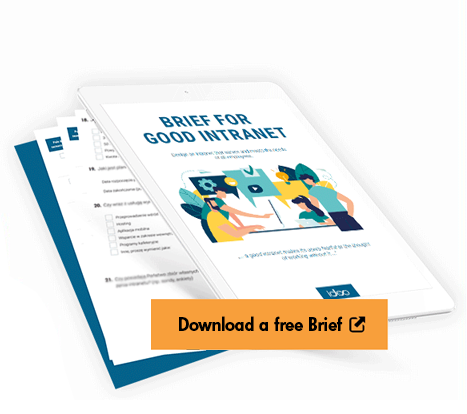100 questions to ask... Intranet pre-implementation checklist
The Intranet Brief we published has been very popular, so we've prepared an article to make the analysis work easier. Check out what you need to know before implementing an Intranet Platform.
Designing an intranet is a process to which you should invite as many groups of employees as possible. Starting from the project manager, through the management board, to the people who will use the platform on a daily basis in connection with their work. At the stage of preparation for implementation it is worth collecting and unifying the needs and expectations of each of these groups.
The Intranet Brief is a good starting point for pre-implementation analysis work, both when designing a new intranet platform and when expanding an existing one.
To make it easier to fill out the Brief form, we have prepared a set of questions that can also serve as an introduction to pre-implementation analysis. We hope that this list will improve the planning of building or expanding the intranet in your organization. Its purpose was to draw attention to the non-obvious aspects that are often overlooked in this type of analysis.
For your convenience, we have also prepared a complete list of questions also as a PDF file: 100 QUESTIONS TO ASK... about Intranet
Supplier selection
Supplier selection is important as it defines the success of the entire venture. When analyzing the market, it is worth taking into account many aspects from various sources:
- The company's experience, supported by exemplary implementations, preferably in the form of a portfolio. It is worth looking for case studies that not only accurately present each element of the intranet platform implementation, but also the knowledge of specialists.
- Customer opinions (and their profile, industry and size), credentials or ratings on rating portals present the course of cooperation with the service provider in a very detailed manner.
- The awards and honourable mentions prove that the company is an expert in its field.
- The supplier's offer in terms of the technologies used, the proposed hosting solutions, warranty, post-implementation care and technical support - are the determinants of whether the company keeps up with IT development and how it approaches the challenges faced by potential customers.
It is also important to find out whether the service provider specializes in one-time implementations or rather permanent cooperation with the client. It is good to check how the cooperation usually works, what the development / expansion of projects looks like after some time and how the company approaches the topic of after-sales support.
Find answers to the following questions:
- Does the long-term presence of the company go in line with the experience in creating intranets?
- Is it possible to see customer reference letters?
- What technologies are used in implemented projects? Does the company offer an explanation or description explaining why these solutions are recommended?
- What methodologies are used in creating and managing projects?
- What security mechanisms and standards does the supplier mention? What security measures are offered?
- Can you count on a dedicated project supervisor?
- What will the cooperation between the IT department and the implementation team look like?
- How long is the warranty period offered and under what conditions?
- Does the company offer, for example, various hosting solutions to maintain the intranet? What are these solutions?
- What are the conditions for providing technical support? What does it look like, incl. problem response time, incident reporting and what services are included in the selected offer?
- Does the company only use its own resources? Are the projects implemented comprehensively?
- Does the company specialize only in implementations or does it have a comprehensive view of the problem of Intranets and internal communication? Can you count on consulting in the area of business and marketing regarding internal communication as part of the cooperation?
- Can you count on support in analyzing the individual needs of the company?
- Is the offered system consistent with specific needs? Will the system be adapted / designed taking into account the existing processes in the company?
Intranet users’ needs
The success of an intranet platform largely depends on adapting the intranet to the needs of employees and organizations. Each industry will use different tools and devices; a desktop computer, portable computer or smartphone is a standard. In the case of some companies, non-standard solutions may be necessary, e.g. a multimedia kiosk, a public monitor, etc. It is also important to determine whether each employee will be able to log into the new intranet and will use an individual or, for example, affiliate account.
It is also important to take into account the organizational structure, company hierarchy, or indicate the source of data that will then be uploaded to the intranet. The next step is to define the information needs for individual departments, positions and individual tasks performed by employees. It is necessary to determine whether the designed intranet function will support subordinates in their work, optimizing the time and number of activities performed. We also encourage you to download our intranet brief, where you will find a lot of functional ideas for designing an intranet.
Find answers to the following questions:
- What is the organizational structure of the company? What departments are the employees divided into?
- Is it possible to prepare employee surveys or meetings with employees from various departments?
- How will the collected information be analyzed and who will be responsible for this task?
- Will there be special templates for declamations sent in the form of a file or online surveys?
- Will integration with communication or collaboration tools be required?
- What functions exactly will be included in the intranet? Will there be elements typical for social media portals (photo galleries, the possibility of commenting, rating, etc.)?
- Should KPI dashboards be an integral part of the intranet home screen? What other elements should be on the home page?
- Will employees be able to personalize the screen and set widgets and shortcuts to the applications they need?
- Will the intranet be integrated with other systems operating in the company? What and to what extent?
- Will it be required to introduce functionalities related to the HR and Finance departments (holiday requests, time of work record, settlements, etc.)?
- Is there a list of ideas for new intranet features that could be implemented in the future?
The Intranet Platforms / Digital Workplaces designed by us, help in the day to day operations of:

Editorial board
Right next to the implementation of the intranet, the key element is monitoring its development and efficient operation, for which the editorial staff is responsible. Before implementing the intranet, the staff is responsible for promoting the intranet among employees.
It is important to choose a chief editor, intranet or internal communication specialist (IC specialist who is the "liaison" for all departments of the company. This person collects, analyzes and controls information, and then calculates whether introducing certain functions on the intranet is justified and profitable. They also collect suggestions from employees and then implement them in the system, determine the effectiveness of the intranet and work closely with administrators and developers in this regard.
Find answers to the following questions:
- How will the intranet development team be structured? How many employees will be involved in this project?
- What roles will each member play? (Intranet manager, editors, department heads, administrators, etc.) 3
- How often and in what form will meetings with the editorial staff be organized?
- Will training in the use of the system management panel, CMS (Content Management System) be required for all staff members?
- What will the workflow for developing and publishing content look like?
- Who will be responsible for: content creation, verification, publication, introduction, formatting and updating.
- Which media will be used in the platform: audio, video, infographics, other?
- Will employees involved in the development of the intranet be rewarded in some way for their efforts? If so, in what way?
The structure and graphic design of the intranet
 When designing any application or system, an extremely important element is the structure, intuitive navigation and a satisfactory visual effect. It is also worth remembering that designing, for example, native applications, and designing systems, is based on other UX and UI assumptions. We will write more about it in the section "Intranet access channels", but here we take into account the architecture of the intranet content, all integrations, navigation and graphics.
When designing any application or system, an extremely important element is the structure, intuitive navigation and a satisfactory visual effect. It is also worth remembering that designing, for example, native applications, and designing systems, is based on other UX and UI assumptions. We will write more about it in the section "Intranet access channels", but here we take into account the architecture of the intranet content, all integrations, navigation and graphics.
Find answers to the following questions:
Content architecture
- What items will the menu contain and how will it be grouped?
- What types of content will be published on the intranet platform?
- What content or functions / modules should be available only to selected people or departments? What are these departments? What intranet features should be available to all employees?
Integrations
- How many intranet systems should it be integrated with? What is the justification for using a given system and its integration with the intranet platform?
- What data types and content will be integrated? Will it be one-sided integration (only reading information from other systems) or two-sided (saving data from the intranet also to other systems in real time)?
- How is it planned to connect the existing systems to the new intranet?
- Are data migrations to other systems expected in the near future?
Navigation
- Is there already an architecture and website layout design?
- Which of the navigation elements should be changed to work as usual? 3
- Are you planning to create an intranet mock-up that will allow you to test the layout as well as the main functionalities and navigation of the intranet before starting the implementation?
- Should the most frequently used content and functions be always visible, for example, as permanent interface elements (on the home page, in the top, in the footer, as blocks)?
- Should the intranet contain content tagging mechanisms in the context of alternative document discovery?
- Will it be possible to adjust e.g. the user's home screen to their preferences, e.g. to set their own shortcut panel? What other personalization options can be used on the intranet?
Graphic design
- Does the system have to comply with the top-down assumptions of the graphic design as part of Corporate Identity?
- What brand elements must be taken into account when designing the graphic design? (e.g. logo, font, materials already available)
- Does the company have a graphic design ready or to be updated?
Intranet access channels
The most popular access we deal with is the one through the company's local network. In order for an employee to be able to connect to a given intranet function, they must then be on the premises of the company and use the company's equipment. At the same time, when it is even outside the company building (or simply within network coverage), these functions become unattainable. Such limited access is called on-premise intranet.
An alternative solution is - making the intranet available outside the company. It is divided into remote access or in Cloud-based solutions. It is important to analyze the situations in which subordinates use the intranet and the scope of information that the company can expose to the outside in this way. Data security is key.
Find answers to the following questions:
General intranet access
- How will employees be able to access the intranet? Is it with a domain login or through a local intranet account?
- Are there any restrictions on web browsers? Do your organization's policies dictate that employees use specific browsers?
- Does the organization have branches / copartnerships? If so, will it be required to create a separate intranet for each of them, or will the intranet be shared? What will be the dependencies?
- Will the Intranet be available only to full-time employees? If not, what other groups of employees will be using the information on the platform? Do all people have Active Directory accounts?
- Should all employees have access to the same information on the intranet or will it have to be divided into types of data (e.g. public, confidential, sensitive, access for selected groups - what?).
- Will the intranet be available only to employees residing in the company's premises (i.e. in one network with the use of domain login)? Will it be possible to log into the company's network via VPN for people outside the company, e.g. at the customer’s end? Or perhaps every person with access to the Internet will be able to log into the intranet just like to any other website?
Mobile devices intranet access
- Are you considering creating a mobile application that would include the most needed intranet functions?
- The mobile application can be adapted to a given group of employees - what elements would be useful for different groups of employees?
- If not the application, should the intranet be available on mobile devices? How will the intranet be made available on phones / tablets?
Software and technical base
What to choose: an all set platform or design and implement a dedicated application?
The box solution tempts with the promise of a quick implementation, a less complicated pre-implementation process and much lower initial implementation costs. However, when it is necessary to adapt them to the needs and expand them with new functions, in practice it may turn out to be a choice that generates significant costs. This option works well in small companies with low expansion in structures.
A dedicated intranet is associated with higher costs and workload. However, it provides a platform that is 100% tailored to the needs and expectations, which is why it is able to quickly generate savings that will pay back the cost associated with the implementation. It offers a range of possibilities for expansion, process optimization, and integration with the company's systems. It addresses, among others ERP, CRM, financial and accounting and HR systems. Synchronization of these data with each other enables business processes to be carried out in a much shorter time, but also often complete automation. You can adjust and modify these processes to the current conditions and needs of a given company. In such an arrangement, the intranet often fills a technological niche in the company and serves as a link between various systems in the organization, making it easier for the user to obtain relevant information.
The pre-implementation analysis provides the answer to the question which option to choose. It allows you to choose the right software, which will prevent the risk of generating additional costs.
Find answers to the following questions:
- What systems are used in the company? Which of them are most often used by employees from particular departments?
- Will all of them require integration with the intranet platform? What is the business case for each of them?
- What technological base does the company have? (e.g. operating systems, databases, own servers or servers leased from an external provider, Cloud platform, own SSL certificates).
- What technologies does the security department prefer and what are the guidelines for an intranet application?
- Will the intranet be kept outside or on the company's own servers?
- What will be the authentication technology and is SSO (Single Sign On) planned?
Intranet implementation cost and time
It is worth striving to conduct a pre-implementation analysis for the intranet platform. As a result, the financial risk is minimized. In turn, you can get a complete picture of the investment. Together with the supplier, it is worth estimating the budget initially and considering which elements are important at the start and which can be postponed. A good solution is to create a plan and determine the costs and duration of the entire project, and then confront them with the financial possibilities.
Often, clients require the system to be implemented quickly and cheaply. Imposing too much pressure on the supplier may result in the return of simplified, not fully thought-out functionalities.
Find answers to the following questions:
Implementation cost
- Has a budget been set for the implementation of the intranet platform?
- Does the budget provide for technological base (e.g. SSL certificates, servers, domains, license costs and others?) Are fixed and variable costs taken into account? What are these elements?
- Does the budget include unforeseen expenses (e.g. new functionalities or further integration)?
Implementation time
- Is there an expected date for the intranet to start? Does the entire system have to be completed within this deadline, or can the implementation be divided into stages?
- How much time will be spent planning and implementing the intranet?
- Will it be required to prepare materials or content for the intranet? Who will carry out the work and when?
- Will data be migrated or will it have to be entered manually - how long will it take?
Training for editors and users
When the organization already has this type of solution in place, employees have some experience and familiarizing themselves with the system should not be a problem or take a long time. If the solution is completely new, it is necessary to encourage employees to use the intranet platform.
During the training, the goals should be very clearly defined and combined with their practical application and individual expectations of the employees themselves. This way, they will not only get more involved, but will also be more motivated to use the intranet platform systematically. At the training, future intranet users should be able to implement new tools in practice.
Find answers to the following questions:
- Who will be responsible for the preparation of training materials - implementation company or editorial team? Who will conduct the presentation?
- How much time should you spend on training? Will it be one meeting or recurrent meetings?
- Will there be a collective training for all employees or individual meetings, e.g. for departments?
- In what mode will they be executed (stationary and / or remote)?
 Do you need an efficient internal communication platform? Our experts will be happy to advise you on optimal solutions. Make an appointment for a free consultation.
Do you need an efficient internal communication platform? Our experts will be happy to advise you on optimal solutions. Make an appointment for a free consultation.
Intranet brief
The intranet offers a long list of new opportunities. It is purely up to you which of them you will make use of.
We present a free interactive brief - document for download - which, question after question, will guide you through key areas that are worth considering when analyzing the needs of the new intranet. Even if your organization already has an intranet platform implemented, it is worth considering whether / how you can improve it.
This document will help you think about your needs and expectations, and compare what features your Intranet has with what else you can add to it. It is not an ordinary form to fill in, but an interactive tool that supports teams in planning a modern intranet.




















